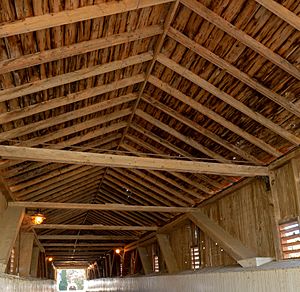West Montrose Covered Bridge facts for kids
Quick facts for kids West Montrose Covered Bridge |
|
|---|---|
 |
|
| Coordinates | 43°35′08″N 80°28′53″W / 43.5855°N 80.4814°W |
| Carries | vehicles |
| Crosses | Grand River |
| Locale | West Montrose, Ontario |
| Maintained by | Waterloo Region |
| Website | https://www.explorewaterlooregion.com/listing/west-montrose-covered-bridge/ |
| Characteristics | |
| Design | covered bridge |
| Material | concrete (piers), metal (truss), wood (sides, some beams) |
| Total length | 205 feet (62 m) |
| Width | 17 feet (5.2 m) |
| Number of spans | 2 |
| History | |
| Architect | John Bear |
| Construction begin | 1880 |
| Construction end | 1881 |
| Construction cost | $3,197.50 (1881) |
| Opened | 1881 |
| Inaugurated | 1881 |
| Statistics | |
| Daily traffic | Minimal (3 tonne limit) |
The West Montrose Covered Bridge is also known as the "Kissing Bridge". It is a special covered bridge located in West Montrose, Ontario. This bridge is one of the oldest covered bridges still standing in Canada. In 2015, there were fewer than 200 covered bridges left in the whole country.
The bridge was built between 1880 and 1881. It was made mostly from strong oak and white pine wood. The builder was John Bear, who had experience building barns. The total cost to the local government was about $3,197.50. Today, people can still use the bridge to cross the Grand River. It is open to walkers, horse-drawn buggies, and vehicles that weigh less than three tonnes. Since 1998, the Regional Municipality of Waterloo has owned and taken care of the bridge.
The bridge's first design used a special way of building called a "Howe truss". It also had two windows with slats, called louvred windows. The whole bridge was first built completely from wood. Its weight was held up by 15 large poles pushed deep into the riverbed. When it was built, people thought it would last about 70 to 80 years. However, many repairs and upgrades have made it last much longer. Over time, concrete and steel parts were added to make the old bridge stronger. Even with these changes, the bridge still looks very much like its original design.
Contents
History of the West Montrose Bridge
The first plans for this bridge appeared in 1880. John L. Wideman from nearby St. Jacobs, Ontario asked for bids to build a covered bridge over the Grand River. The cost would be shared by the Ontario government and the local Woolwich township. The building job was given to John and Benjamin Bear, known as the Bear Bros.
John Bear created the drawings and detailed plans for the bridge. He said that hard wood would be used for most of the bridge. However, the roof supports and side panels would be made of pine. The wood came from nearby villages like Bridgeport and Doon. The bridge officially opened on November 15, 1881. It was painted in May of the next year with a special oil and fireproof paint.
Life Around the Bridge
Starting in the mid-1800s, many Mennonite German families from Pennsylvania settled in this part of Waterloo County. They often traveled by horse and buggy. In winter, they would change their buggy wheels for sleigh runners. This meant the local government had to hire someone to shovel snow onto the bridge. This helped protect the wooden floor from damage by the sleighs.
From 1885 until 1950, oil lamps lit the inside of the bridge at night. These lamps were later replaced with electric lights. The West Montrose Covered Bridge was not the first covered bridge in Waterloo County. The Shingle Bridge in Blair was built before 1835. It was the first of its kind but was washed away by floods in 1857. By 1900, there were only five covered bridges left in all of Ontario.
Keeping the Bridge Strong
The bridge has been repaired and updated many times over the years.
- After 1900, the wooden supports at each end were replaced with concrete.
- In 1904, new wooden planks were laid over the oak floor.
- New wooden support beams were put in place in 1933.
- In 1955, part of the floor was replaced and covered with crushed stone.
- In 1959, parts from an old metal bridge were used to strengthen the inside. These metal parts were then covered with pine panels.
- The roof was re-shingled in 1987.
- Some beams were replaced in 1995 and 1996.
- In late 2012 and early 2013, a floor beam was replaced, and some roof repairs were done.
In 1959, the township built a new concrete bridge nearby. This new bridge helped direct most traffic away from the old covered bridge. This helped the covered bridge last much longer by reducing the number of heavy vehicles using it.
The "Kissing Bridge" Name
Local people who drove their horse and buggy through the bridge started calling it the "Kissing Bridge." It was said that a kiss was needed as a "toll" to cross it. This was because the bridge offered a bit of privacy inside. A historical story mentions that "local girls learned to be careful when their escort's horse stopped inside the bridge without any command from the driver." This fun story is why a hiking path that goes through the area is called The Kissing Bridge Trailway.
Protecting the Bridge's History
The West Montrose Covered Bridge has been recognized as an important historical site.
- In August 1960, it was named a Provincial Historic Site.
- In 2007, the Township of Woolwich officially recognized its cultural importance.
- It was added to the Canadian Register of Historic Places on November 28, 2007.
- In 2018, it was one of eight bridges recognized by the region's Heritage Bridge Recognition Program.


